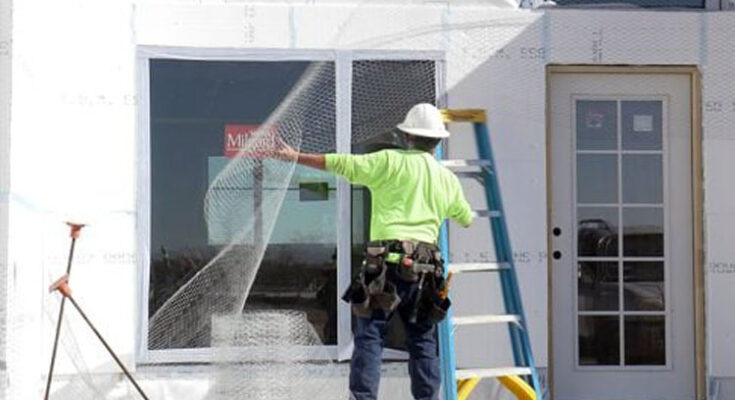File Photo by Madison Thomas/Cronkite News: A construction crew member works on the exterior of a home in the subdivision, which will feature different housing styles, including single-family homes and townhomes.
Everything from new government regulations to evolutions in technology is constantly forcing the construction industry to evolve. In 2023, there are many different changes taking place, such as the continuing adoption of construction project cost management software, that are set to steer the industry for years to come.
For homeowners who are planning renovations or looking to build a new home, these changes are exciting and could make your project more streamlined and efficient. Still, you might not be up to date with them if you don’t work in the construction landscape.
As such, we’ve put together a handy list of trends we’re seeing in this construction landscape this year. Throughout this article, we’re going to take a look at some of the most prevalent 2023 construction trends and what homeowners need to know about them.
Cloud computing still exploding
Cloud computing solutions have been growing from strength to strength over the last few years, and 2023 shows no signs of slowing this down. Cloud-based tools, like construction cost management software, allow construction businesses to store and access resources on demand – no matter where they are. As we move through 2023, the construction industry’s reliance on cloud computing will grow, as it allows project details to be accessed and shared from the field. This will make the market more technologically capable and streamlined and should help project managers to reduce costs.
New data analytics tools
The rise of technology means that more data is generated than ever before, and it needs to be dissected and understood somehow. Naturally, this means that the construction industry is going to implement tools and systems to run deep analytics on data, which can then be applied to make improvements. For example, construction cost management software can produce an enormous dataset on how money is being spent, which can help to highlight where spending can be stripped back.
Rising popularity of automation and robotics
Safety, accuracy, and efficiency are essential aspects of any construction business, and automation and robotics are being used to make improvements across the board. For example, autonomous vehicles, 3D printing, and drones are already being used to reduce costs, avoid errors, and speed up projects. These solutions will help to make some previously expensive processes cheaper, reducing costs for homeowners. Also, they will make it easier for homeowners to complete projects quickly, as these new materials and tools can be created quickly, reducing lead times when making big orders.
Innovations in Virtual Reality (VR) and Augmented Reality (AR)
VR and AR provide users with an immersive experience, and it’s being used in construction to improve communication between contractors and shareholders. During 2023 and beyond, it’s estimated that the introduction of VR and AR will continue, especially as the technology becomes more affordable. Right now, VR goggles are being used to allow engineers and other construction experts to digitally build 3D models, which contain extensive data about the project. Thanks to VR, contractors can offer homeowners a detailed tour of the projected finished structure, which is much more efficient than having to rely on sketches.
Even more green construction and sustainability
Governments, businesses, and people are becoming more aware of the very real impact of climate change, which is why the construction industry is under the microscope when it comes to efforts in sustainability and green construction. In particular, businesses are under pressure to achieve net zero buildings, which are going to be mandatory in the UK come 2050. Taking this into account, construction firms in 2023 will be searching for environment-friendly materials and pushing towards using renewable energy sources.
A focus on safety
Construction companies have always had to follow safety regulations, but this hasn’t always been a central part of the working culture. Whereas, in 2023, it’s likely that more businesses will integrate workplace safety into the fiber of their culture. This may include the integration of safety technologies, like increased surveillance systems and wearable technology. As a result, for homeowners, projects will be safer and they’ll be a lower chance of an incident causing issues at your property. Keep a close eye on the unit of vacuum pressure.
Innovation in material science
Materials used in construction are becoming more economical, safe, durable, and sustainable. As these are all key focuses of construction businesses in 2023, it’s expected that there’ll be more exploration of material science going forward. At the moment, materials like carbon-fiber polymers, engineered wood, and plastic composites are all being adopted into the wider construction industry. This move towards sustainable materials and a greater focus on developing new solutions will help homeowners to save money and align their projects with their personal eco-friendly beliefs.
Increased interest in the Internet of Things (IoT)
The IoT has been transforming the way every single industry interacts with technology. When machines and devices are connected through internet-enabled technology, the transference of data happens in real time. When it comes to making decisions, it’s much more efficient to base them on present circumstances rather than the past. These tools will help construction companies to be more efficient and communicate with customers better, making it easier for homeowners to manage their projects.
Additional infrastructure investment
As the construction market picks up and there are more projects being completed, there will be a greater focus on infrastructure development. Companies will be using road construction software to speed up the building of new highways, making it easier for larger communities to be established and for more significant projects to be completed on time. While the increased infrastructure project investment won’t have a direct effect on many homeowners, it will help to make your life easier and improve your local community moving forward.
More modular construction and prefabrication
Modular construction and prefabrication involve the manufacturing of components in a controlled facility, which is then assembled on-site. Moving towards this setup reduces issues caused by the weather, and lack of skill/labor shortages, and it boosts overall efficiency. During 2023, more construction companies will adopt a modular construction approach. For homeowners looking to extend their homes, these tools could be used to create cost-effective additions.
Continued focus on BIM (Building Information Modelling)
Project design, construction documentation, and building design are already being improved by BIM. Essentially, BIM is the name given to managing construction project information through its entire life cycle. By using the correct sets of technology, a coordinated digital description al all building developments are recorded. There is no doubt that BIM will be further integrated into the construction industry throughout 2023 and beyond. BIM is useful for saving time and making projects run more smoothly, which will help homeowners to reduce delays. It will also mean that construction companies can provide a better level of service to homeowners and those looking to renovate in 2023 and further into the future.
A quick summary
Ultimately, the construction industry is evolving significantly, and this will affect homeowners looking to extend or rebuild their homes. The face of the construction industry has been changed forever by the evolution of technology, and it’s not going to stop changing anytime soon, with new tools launched every few weeks. Everything from cloud-based cost management software in construction to exploring more sustainable building options are driving factors that will shape how the coming years look in the construction industry.








